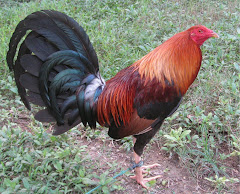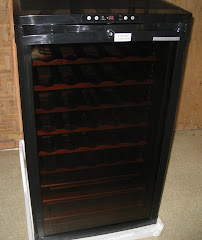Sunday, March 29, 2009
Cannibalism: Prevention and Treatment
By Phillip J. Clauer, Poultry Extension Specialist Animal & Poultry Sciences Department - Cannibalism in fowl is a costly and vicious habit that poultry producers can not afford to ignore. It may occur at any age among all breeds, strains and sexes of fowl.
Cannibalism usually occurs when the birds are stressed by a poor management practice. Once becoming stressed, one bird begins picking the feathers, comb, toes or vent of another bird. Once an open wound or blood is visible on the bird, the vicious habit of cannibalism can spread rapidly through the entire flock. If you notice the problem soon after it begins, cannibalism can be held in check. However, if the problem is allowed to get out of hand it can be very costly. Cannibalism will lower the birds value due to torn and damaged flesh, poor feathering and can result in high death losses. Once this habit gets out of hand it is difficult to eliminate.
Since there are numerous reasons for outbreaks of cannibalism, it is important that cannibalism control be a part of your management program.
I. Cannibalism is usually caused by one or more of these conditions:
1. Overcrowding: chicks should be allowed:
1/4 sq. ft./bird for first 2 weeks
1/2 sq. ft./bird for 3-8 weeks
1 sq. ft./bird from 8 to 16 weeks of age
1.5 sq. ft./bird from 16 weeks on
With gamebirds, double the above recommendations. With pheasants, allow 25 to 30 sq.ft./bird after 12 weeks of age or use pick prevention devices.
2. Excessive heat: When the birds become uncomfortably hot they can become extremely cannibalistic. Be sure to adjust the brooding temperature as the young fowl get older. Brood young fowl at 95°F. for the first week and then decrease the temperature 5°F. per week, until you reach 70°F. or the outside temperature. The temperature should be measured at the height of the birds back directly under the heat source. Do not heat the entire brooding facility to the recommended temperature.
3. Excessive light: Extremely bright light or excessively long periods of light will cause birds to become hostile toward one another. Never use white light bulbs larger than 40 watts to brood fowl. If larger bulbs are required for heat, use red or infra-red bulbs. In birds 12 weeks of age or older, use 15 or 25 watt bulbs above feeding and watering areas. Don't light fowl more than 16 hours per day. Constant light can be stressful to the birds.
4. Absence of feed or water or a shortage of feeder and waterer space: If the birds have to fight for food and water, or if the birds are always hungry they will increase pecking. Be sure that birds have free access to water and feed at all times.
5. Unbalanced diets: Extremely high energy and low fiber diets cause the birds to be extra active and aggressive. Feed lacking protein and other nutrients, particularly Methionine, will also cause birds to pick feathers. Make sure you feed a diet balanced appropriately for the age and types of fowl you are raising.
6. Mixing of different types and colors of fowl: Mixing different ages of fowl or fowl with different traits promotes pecking by disrupting the flocks normal pecking order. Never brood different species of birds together. Don't brood feathered leg fowl, crested fowl or bearded fowl with fowl without these traits. Curiosity can also start pecking.
7. Abrupt changes in environment or management practices: If you plan to move young birds to a new location, it is best to move some of their feeders and waterers with them in order to help them adapt. When you change over to larger feeders and waterers it is helpful to leave the smaller equipment in the pen for a few days to help during the change.
8. Brightly lit nests or shortage of nesting boxes: Don't place bright lights near the nesting areas. Also, allow 1 nest for every 5 hens. Vent pecking by layers is also a common problem.
9. Allowing cripples, injured or dead birds to remain in a flock: Fowl will pick on cripples or dead birds in their pens because of the social order and curiosity. Once pecking starts it can quickly develop into a vicious habit.
10. Slow feathering birds are most prone to cannibalism: Take extra precautions with slow feathering birds. Most cannibalism occurs during father growth in young fowl. Birds with slow feathering have immature tender feathers exposed for longer periods of time leaving them open to damage from pecking. Don't raise slow feathering birds with other fowl.
II. Additional preventive measures include:
1. Allow the birds to use up their energy in an enclosed outside run. This will keep the birds busy and allow them to peck greens, ground and insects instead of other birds.
2. Give the birds a large handful of fresh greens like clover grass or weeds, each day. This increases the fiber in the birds diet. High fiber diets keep the birds crop full and makes the birds more content.
3. Use of mechanical devices in aggressive birds like gamebirds is advisable.
4. Finally, beak trimming is used in most commercial laying flocks. Trim the beak by remove _ of the tope beak and about 1/3 of the lower beak providing a square tip. This makes it difficult for the birds to harm each other. However, beak trimming should b done by someone experienced in proper trimming.
III. Treatment for a cannibalism outbreak:
1. Since cannibalism can be caused by several conditions, you may not be able to determine the exact cause of the problem. However, stress no matter how slight, is usually the main factor.
o Try to correct any practices which may have lead to cannibalism.
o Darkening the facilities by using red bulbs.
o Remove any badly injured birds.
o Applying an "anti-peck" ointment or pine tar on any damaged birds usually stops pecking.
o Lower the pen temperature a bit if possible.
o Don't take chances! Make the cannibalism control part of your management program and you will save a great deal of time and money.
Source: University of Virginia Virginia Cooperative Extension - July 2004
Welcome. To read the articles, please click post link or month, then subsequent post link.
Ponkan broodcock

One of the ponkan broodcocks being readied by RB Sugbo for the incoming breeding season. RB Sugbo is among the gamefowl farms very much involved in the Masang Nagmamanok (MANA) Inc. nationwide gamefowl dispersal program.
Another ponkan

Another ponkan broodcock in the trio pen.
Mana: Dami at Pagkakaisa
Walang duda napakalaki na ng pinagunlad ng sabong mula sa paging libangan tuwing araw ng Linggo, ito ngayon ay isa nang napakatanyag na isport, malaking industriya at kaakitakit na mapagkakitaan.
Napakarami nang nagpapalahi ng manok panabong. Nagsilabasan ang mga babasahin at programa sa telebisyon ukol sa sabong.
Sa bawat nagpapalahi, ilan ang tagapagalaga ng kanyang manok? Sa bawat may-ari ng sabungan, ilan ang naghahanapbuhay sa sabungan niya? Sa bawat kasali sa derby, ilan ang nagbabayad sa pinto upang manood? Sa bawat malaking sabungero, ilan ang mayroon lang iilang pirasong tinale sa kanilang bakuran? Dapat lang, at napapanahon na siguro, na ang masang sabungero ay mapagtuonan ng pansin, mabigyan ng kinatawan, at, marinig ang boses sa isport at industriya ng sabong.
Ito ang nais abutin ng MANA (Masang Nagmamanok), isang pambansang kilusan at samahan ng mga masang sabungero. Ang mga layunin ng MANA ay ang sumusunod:
1. Ang pangalagaan ang kapakanan ng mga maliit na sabungero, partikular na, ang mga naghahanapbuhay sa sabungan. Inaasam na sa darating na panahon, ang mga handlers, mananari, casador, kristos, sentensiyador, farm hands ay magkakaroon ng mga benepisyo tulad ng insurance, pension at iba pa.
2. Ang mapatingkad ang kaalaman ng ordinaryong sabungero sa pagmamanok. At, sila’y mabigyan ng pagkakataon na magkaroon ng angkop na materyales sa pagpapalahi at paglalaban.
3. Ang ipaglaban ang sabong sa gitna ng banta na itoy gawing labag sa batas tulad ng nangyari kamakailan lang sa Estados Unidos, at ipreserba ito bilang isport, hanapbuhay, industriya at bahagi ng ating kultura at tunay na mana.
4. Ang magtulungan at makipagtulungan sa iba pang haligi ng industriya sa ikabubuti ng sabong at ikauunlad ng lahat na mga sabungero.
Inaasahan na matupad ng MANA ang nasabing mga layunin pamamagitan ng pagpakita ng dami at pagkakaisa.
Ang pagkatatag ng MANA ay bunsod ng mungkahi ni kamanang Boying
Ang Llamado Tayo ay tumatalakay sa ibatibang aspeto sa pagmamanok at binabasa ng napakarami arawaraw, kaya di nagtagal marami ang sumapi sa MANA.
Kasunod nito, ang MANA ay nakapagpaseminar sa ibatibang lugar at rehiyon ng Pilipinas, sa tulong ng mga kumpaniya tulad ng Excellence Poultry & Livestock Specialist, Bmeg-Derby Ace, Sagupaan, Secret Weapon, at Thunderbird.






